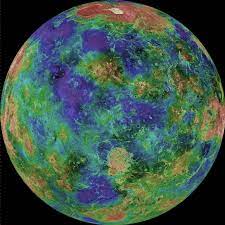


Venus, often referred to as Earth’s “sister planet” due to their similar sizes and compositions, is a fascinating celestial body with a myriad of intriguing characteristics. While it might not be as well-known as some other planets in our solar system, Venus boasts a range of peculiar features that make it a subject of great interest for astronomers and space enthusiasts alike.
Retrograde Rotation
One of the most peculiar features of Venus is its retrograde rotation. Unlike most planets, including Earth, which rotate counterclockwise on their axes, Venus rotates in the opposite direction—clockwise. This means that if you were standing on the surface of Venus, the Sun would rise in the west and set in the east, making for an incredibly unusual daily cycle. Scientists believe that this retrograde rotation might have been caused by a massive collision with another celestial object in the distant past, disrupting Venus’s original rotation.
Super-Rotating Atmosphere
Venus has an incredibly thick and toxic atmosphere composed mainly of carbon dioxide with clouds of sulfuric acid. What makes its atmosphere even weirder is the super-rotating winds. Despite its slow rotation on the surface, Venus’s atmosphere whips around the planet at astonishing speeds, reaching hurricane-force winds of up to 360 kilometers per hour (224 miles per hour) in its upper cloud layer.
Longest Day Shorter Than Its Year
A day on Venus (one full rotation on its axis) is longer than a year on Venus (one orbit around the Sun). Venus takes about 243 Earth days to complete one rotation on its axis, making a day on Venus longer than a year on the planet. However, its orbit around the Sun takes approximately 225 Earth days.
Runaway Greenhouse Effect
Venus experiences an extreme greenhouse effect, making it the hottest planet in our solar system despite not being the closest to the Sun. The thick atmosphere traps heat, creating a runaway greenhouse effect where temperatures soar to a scorching 462 degrees Celsius (864 degrees Fahrenheit) on the surface. This intense heat is even hotter than the surface of Mercury, the closest planet to the Sun, making Venus a hostile and inhospitable environment for any form of life as we know it.
Mysterious Dark Streaks
Venus’s surface is covered in vast plains, mountains, and volcanoes, but it also features mysterious dark streaks that puzzle scientists. These dark streaks, known as “lineae,” are several kilometers long and a few hundred meters wide. The exact origin of these streaks remains unknown, but scientists speculate that they might be related to volcanic activity or some other geological processes.